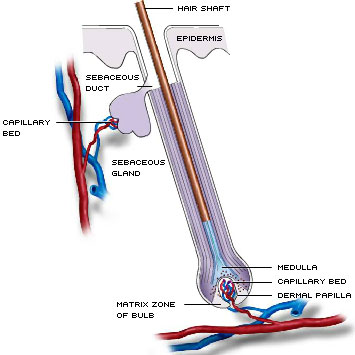Consider the cells where hair is made. Hair is made in the hair follicles1 (discussed below). Capillaries come in close contact with the cells of the follicle (Figure 3) and provide oxygen and glucose and other nutrients that are essential for the function and survival of these cells. The capillaries also surround sebaceous glands connected to the follicles. These glands secrete sebum2 (mostly lipids) into the follicle to keep it from drying out. Because the capillary membranes have small pores in them, drugs and other small molecules can leave the capillary easily to enter the follicle. Drugs3 in the blood also have access to the follicles by traveling through the sebaceous glands.
Figure 3 Capillaries surround the bulb of the hair follicle and the sebaceous gland.
Definitions:
1 a small sac; hair follicles are internalized structures of epithelial cells in which the hair is synthesized and grows
2 a fatty substance made in and secreted by sebaceous glands attached to hair follicles
3 a substance that affects the structure or function of a cell or organism.

